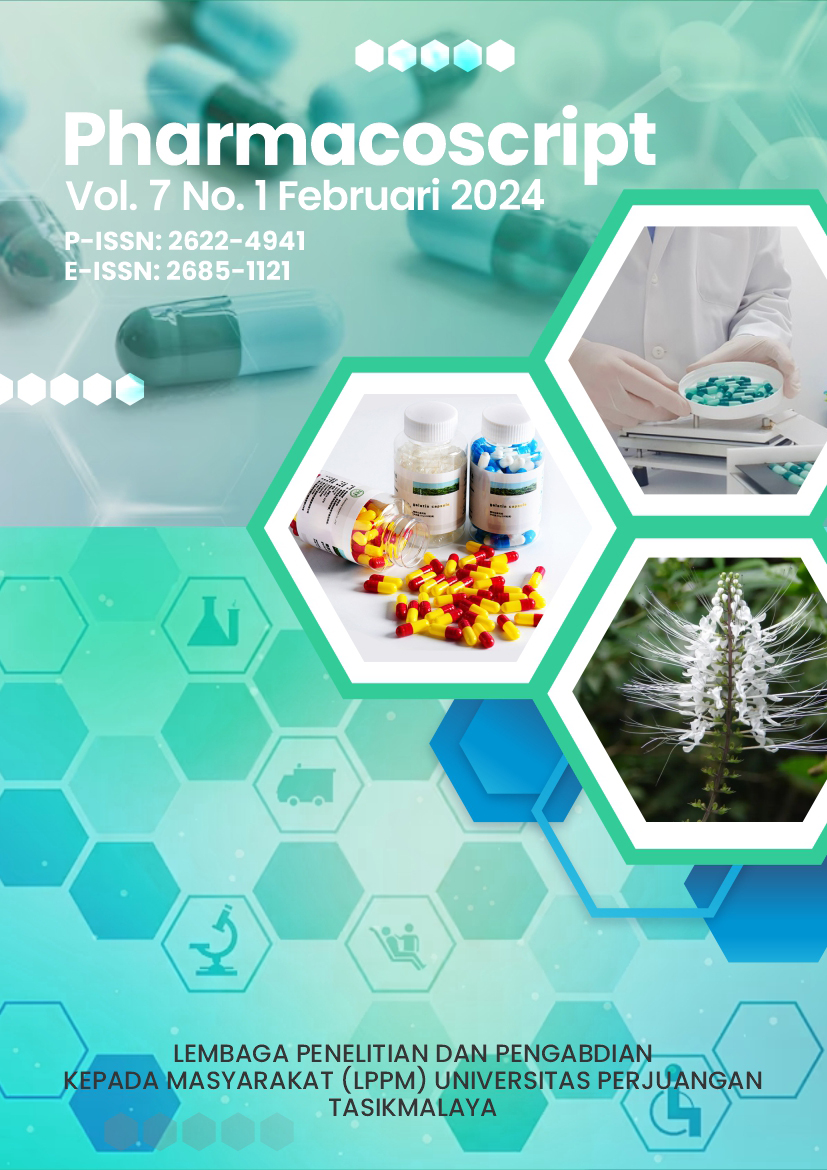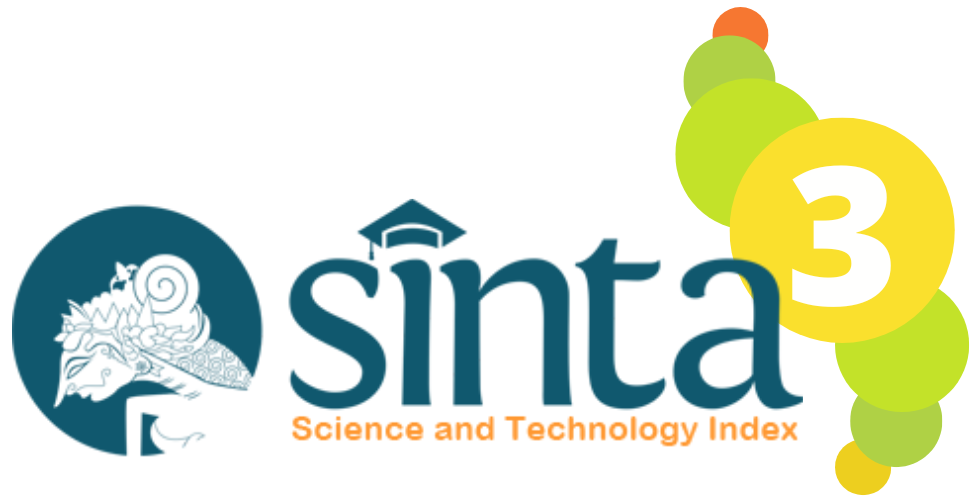AKTIVITAS ANTIBIOFILM EKSTRAK DAUN PEPAYA (Carica papaya L.) TERHADAP Staphylococcus aureus
DOI:
https://doi.org/10.36423/pharmacoscript.v7i1.1552Keywords:
antibiofilm, daun pepaya (Carica papaya L.), biofilm, Staphylococcus aureus, MBICAbstract
Daun pepaya (Carica papaya L.) mengandung alkaloid, tanin, steroid, flavonoid dan papain yang dapat menghambat perlekatan sel dan pertumbuhan Actinomyces. Tujuan penelitian ini untuk melihat aktivitas antibiofilm ekstrak daun pepaya terhadap Staphylococcus aureus, bakteri penyebab infeksi dan resisten terhadap beberapa antibiotik. Staphylococcus aureus memiliki resistensi antibiotik yang lebih tinggi dalam bentuk biofilm dibandingkan dalam bentuk plankton. Uji turbidimetri dilakukan pada 96 well plate dengan penambahan kristal violet. Metode maserasi dilakukan dengan pelarut air steril digunakan untuk mengekstraksi pada simplisia daun pepaya. Selanjutnya dibuat ekstrak kental daun pepaya diencerkan sehingga diperoleh dengan sepuluh konsentrasi berbeda dengan interval konsentrasi 9,76 – 5000 μg/mL.Tetrasiklin HCl dengan konsentrasi yang sama dengan ekstrak uji digunakan sebagai antibiotik pembanding. Uji aktivitas antibiofilm pada Staphylococcus aureus menunjukkan bahwa ekstrak daun pepaya memiliki aktivitas antibiofilm pada konsentrasi 625, 1250, 2500, dan 5000 μg/mL serta dapat menghambat pembentukan biofilm dengan nilai MBIC dari 625 g/mL.
References
Alvita, L. R. (2015). Aktivitas Antibiofilm Dari Bakteri Escherichia Coli Oleh Ekstrak Air Daun Singkong, Pepaya Dan Melinjo Secara In Vitro. 1–45.
Alvita, L. R. (2015). Aktivitas Antibiofilm Dari Bakteri Escherichia Coli Oleh Ekstrak Air Daun Singkong, Pepaya Dan Melinjo Secara In Vitro. 1–45.
Antibiofilm, A., Air, E., Pepaya, D., & Bakteri, L. (2016). The In Vitro Antibiofilm Activity of Water Leaf Extract of Papaya ( Carica papaya L .) against Pseudomonas aeruginosa. 2(3), 150–163.
Ashaye, O., & Fasoyiro, S. (2014). Chemical and Organoleptic Characterization of Pawpaw and Guava Leathers Chemical and Organoleptic Characterization of Pawpaw and Guava Leathers. June, 5–7.
Brock 1926-2021 (viaf)108182990, T. D., Madigan, M. T. (viaf)27221308, Martinko, J. M. (viaf)24825109, & Parker, J. (viaf)115234898. (2003). Brock biology of microorganisms (10th ed.). Upper Saddle River (N.J.) : Prentice-Hall.
Davey, M. E., & Toole, G. A. O. (2000). Microbial Biofilms : from Ecology to Molecular Genetics. 64(4), 847–867.
Farnsworth, N. R. (1966). Biological and Phytochemical Screening of Plants. Journal of Pharmaceutical Sciences, 55(3), 225–276.
Gomashe, A. V, Sharma, A. A. and, & Kasulkar, A. (2014). Original Research Article Investigation of Biofilm Inhibition Activity and Antibacterial Activity of Psidium guajava Plant Extracts against Streptococcus mutans Causing Dental Plaque. International Journal of Current Microbiology and Applied Sciences, 3(9), 335–351.
Irie, Y., & Parsek, M. R. (2008). Quorum Sensing and Microbial Biofilms (pp. 67–84).
Kalia, V. C. (2013). Quorum sensing inhibitors : An overview. Biotechnology Advances, 31(2), 224–245.
Kawarai, T., Narisawa, N., Yoneda, S., Tsutsumi, Y., Ishikawa, J., Hoshino, Y., & Senpuku, H. (2016). Inhibition of Streptococcus mutans biofilm formation using extracts from Assam tea compared to green tea. Archives of Oral Biology, 68, 73–82.
Kim, H., Lee, S., Byun, Y., & Park, H. (2015). virulence via quorum sensing inhibition.
Ko, S. J., Kang, N. H., Kim, M. K., Park, J., Park, E., Park, G. H., Kang, T. W., Na, D. E., Park, J. B., Yi, Y. E., Jeon, S. H., & Park, Y. (2019). Antibacterial and anti-biofilm activity, and mechanism of action of pleurocidin against drug resistant Staphylococcus aureus. Microbial Pathogenesis, 127, 70–78.
K.R.Markham. (1988). Cara Mengidentifikasi Flavanoid. ITB Press.
Melchior, M. B., & Vaarkamp, H. (2006). The Veterinary Journal. 171, 398–407.
Mohammed, Y. H. E., Manukumar, H. M., Rakesh, K. P., Karthik, C. S., Mallu, P., & Qin, H. L. (2018). Vision for medicine: Staphylococcus aureus biofilm war and unlocking key’s for anti-biofilm drug development. Microbial Pathogenesis, 123, 339–347.
Mugita, N., Nambu, T., Takahashi, K., Wang, P. L., & Komasa, Y. (2017). Proteases, actinidin, papain and trypsin reduce oral biofilm on the tongue in elderly subjects and in vitro. Archives of Oral Biology, 82, 233–240.
Oliveira, M., Bexiga, R., Nunes, S. F., Carneiro, C., Cavaco, L. M., Bernardo, F., & Vilela, C. L. (2006). Biofilm-forming ability profiling of Staphylococcus aureus and Staphylococcus epidermidis mastitis isolates. 118, 133–140.
Rohde, H., Frankenberger, S., Zähringer, U., & Mack, D. (2010). Structure, function and contribution of polysaccharide intercellular adhesin (PIA) to Staphylococcus epidermidis biofilm formation and pathogenesis of biomaterial-associated infections. European Journal of Cell Biology, 89(1), 103–111.
Viju, N., Satheesh, S., & Vincent, S. G. P. (2013). Antibiofilm activity of coconut (Cocos nucifera Linn.) husk fibre extract. Saudi Journal of Biological Sciences, 20(1), 85–91.
Downloads
Published
Issue
Section
License
Copyright (c) 2024 Mira Andam Dewi, Anggi Gumilar, Wisma Sari Indah

This work is licensed under a Creative Commons Attribution-ShareAlike 4.0 International License.
Authors who publish with this journal agree to the following terms:
- Authors retain copyright and grant the journal right of first publication, with the work [SPECIFY PERIOD OF TIME] after publication simultaneously licensed under a Creative Commons Attribution License that allows others to share the work with an acknowledgement of the work's authorship and initial publication in this journal.
- Authors are able to enter into separate, additional contractual arrangements for the non-exclusive distribution of the journal's published version of the work (e.g., post it to an institutional repository or publish it in a book), with an acknowledgement of its initial publication in this journal.
- Authors are permitted and encouraged to post their work online (e.g., in institutional repositories or on their website) prior to and during the submission process, as it can lead to productive exchanges, as well as earlier and greater citation of published work (See The Effect of Open Access).









